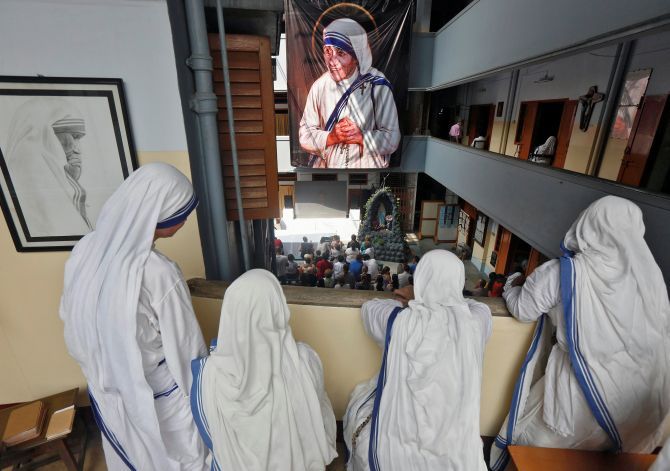Hundreds of thousands of people watched the ceremony in St Peter’s Square, where the pontiff said Mother Teresa was ‘tireless worker for mercy’.

Pope Francis declared Mother Teresa a saint on Sunday, praising the tiny nun for having taken in society’s most unwanted and for having shamed world leaders for the “crimes of poverty they themselves created.”
The pontiff delivered the formula for the canonisation of the Albanian-born nun -- known as the saint of the gutters -- before huge crowds of pilgrims gathered in St Peter's Square in Vatican City on Sunday morning.

Applause broke out before he completed the formula of canonisation, in which he declared ‘Blessed Teresa of Kolkata to be a saint.’
Hundreds of thousands -- including hundreds of blue-and white-robed nuns from Missionaries of Charity sisterhood founded by Mother Teresa -- had gathered from around the world to attend the canonisation of the church's newest saint, just 19 years after her death.

Praising Mother Teresa for her charitable work, he said, “Mother Teresa, in all aspects of her life, was a generous dispenser of divine mercy, making herself available for everyone through her welcome and defence of human life, those unborn and those abandoned and discarded.”
“She bowed down before those who were spent, left to die on the side of the road, seeing in them their God-given dignity. She made her voice heard before the powers of this world, so that they might recognise their guilt for the crime of poverty they created.”
She was an example to volunteers around the world, he said. “May she be your model of holiness.”

Born Agnes Gonxhe Bojaxhiu on August 26, 1910, Mother Teresa came to India in 1929 as a sister of the Loreto order. In 1946, she received what she described as a “call within a call” to found a new order dedicated to caring for the most unloved and unwanted, the “poorest of the poor.”
In 1950, she founded the Missionaries of Charity, which went onto become a global order of nuns priests, brothers and lay co-workers.

She was awarded the Nobel Peace Prize in 1979.
She died in 1997 and was put on a fast-track for sainthood soon thereafter.

Sunday’s festivities honouring Mother Teresa were not limited to Rome and the Vatican.
In Kolkata, where Mother Teresa spent a lifetime dedicated to the poor, a special Sunday Mass was held at the order's Mother House.
Volunteers and admirers converged on Mother House to watch the canonisation ceremony, which was being broadcast on giant TV screens in Kolkata and elsewhere.
THE PROCESS TO BE MADE A SAINT

Even as the solemn canonisation ceremony was underway in faraway Rome, members of the Darjeeling branch of the Lay Missionaries of Charity took an 8-kilometre ride on the iconic Darjeeling toy train to retrace the trip Mother Teresa took on September 10, 1946.
“We wished to experience what Mother Teresa must have felt during that time of September 10, 1946 when she got the ‘call within the call’ during her trip from the plains (NJP-Siliguri) to Darjeeling and her life’s course changed forever,” Father Peter Lingdam, LMC’s Darjeeling Branch Director said.
“Today’s ride in the toy train is symbolic. Maybe some of us will also be enlightened like her,” Father Lingdam said.
On September 10, 1946, during her journey to Darjeeling in the toy train the Mother received the ‘call within the call’ within her soul and the course of her life was decided, the Father said.
Mother Teresa’s legacy remains strong in the hills as apart from LMC chapters, branches of the MC (Missionaries of Charity) continue to work for the welfare of the poor, needy and homeless in Darjeeling, Kalimpong and Kurseong sub-divisions.
Road named after Mother Teresa in Bhubaneswar
An important road in Bhubaneswar was named after Mother Teresa coinciding with her canonisation ceremony at the Vatican.
Dedicating the road linking Satya Nagar and Cuttack-Puri highway in her memory, Chief Minister Naveen Patnaik said henceforth the pathway would be known as ‘Saint Mother Teresa Road’.
“I pay my heartfelt tributes to Mother Teresa on her cannonisation as Saint Mother Teresa. She arrived in India in 1929 and made this country her home to serve the poor, the deceased and the destitute,” Patnaik said.
“It is time for all of us to take a leaf from her book of compassion and service and work for the poor and distressed. Let’s work for the dignity of every human being and the people around us,” he said.








